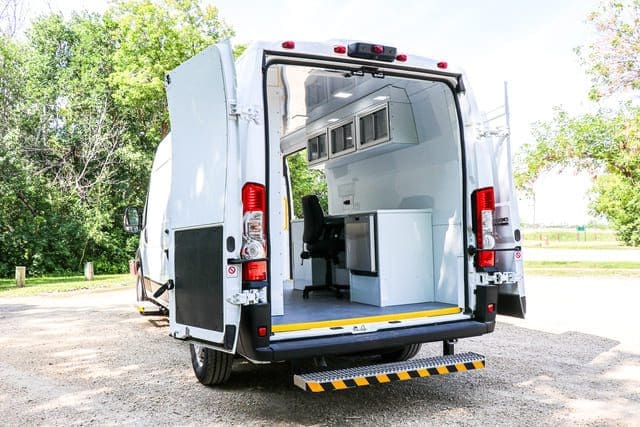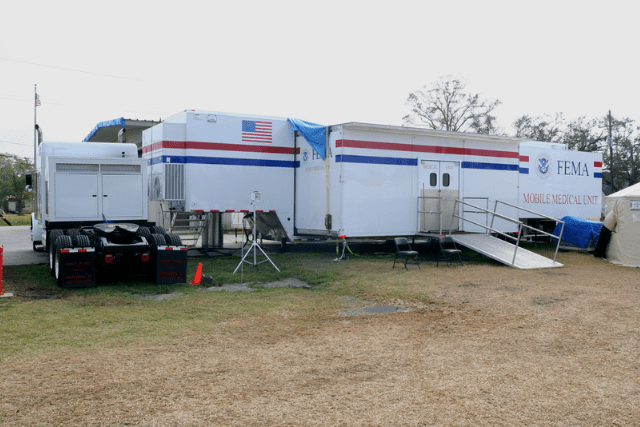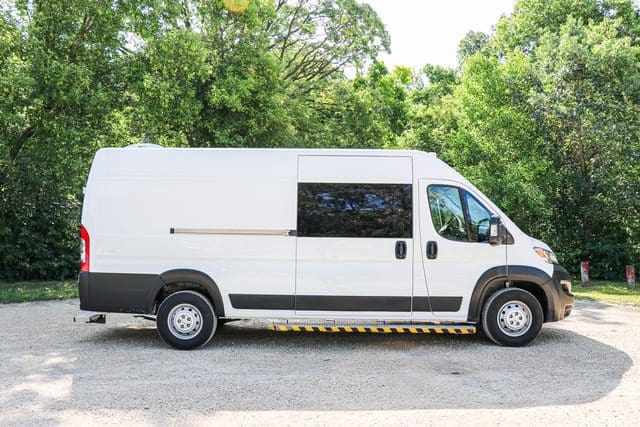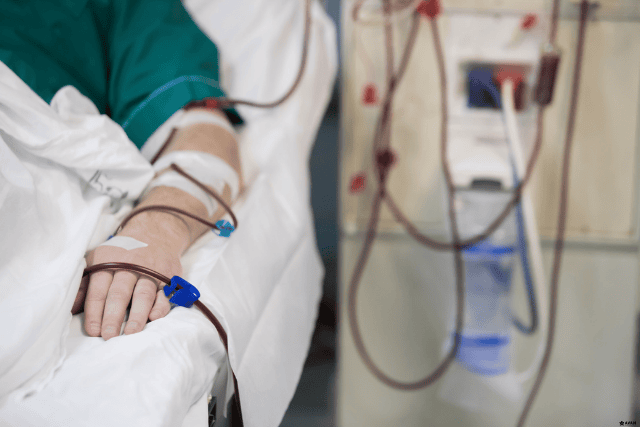Is your organization trying to decide between a mobile medical van vs. mobile medical trailer? Choosing the wrong option will make it hard to fulfill the long-term needs of your organization. Making the right choice will allow you to serve the right clientele with the right equipment at the right cost.
We manufacture mobile medical vans at AVAN Mobility. Throughout the past 10 years, we’ve made hundreds of mobile medical vans for organizations like yours that try to reduce barriers to healthcare. We work with Native Reservations, non-emergency medical transport services, healthcare providers, outreach support organizations, independent living centers, and senior living communities.
When you’re investing lots of money into a mobile medical unit for your organization, you want to make the right choice. In this article, you’ll learn the differences between mobile medical vans vs. mobile medical trailers. By the end of reading it, you’ll have a clearer idea of which option will work best for your organization’s needs.
What are mobile medical vans?

Mobile medical vans are vehicles that are converted into clinics on wheels and can be customized according to your needs. Here are some of the organizations and services that use mobile medical vans:
Native Reservations and communities: People in reservations and Native communities like the Navajo Nation often live far from healthcare centers. Mobile medical vans travel to patients’ homes or nearby locations, providing basic healthcare access.
Housing and homeless societies: Programs working to end homelessness require on-the-spot solutions. Mobile medical vans create a safe environment for social workers to address clients’ needs where they are.
Addiction services: Traditional facilities deter people from seeking addiction help.
Mobile medical vans offer a private, stigma-free space for individuals to receive addiction support.
For example, in small towns in Kentucky, there are mobile medical vans that help folks who are having a hard time because of drugs. People dealing with addiction can go inside these vans and talk to friendly support staff who want to help them get better without feeling embarrassed.
Non-emergency medical response: Custom mobile medical vans cater to non-urgent medical needs. Services like bloodwork, physical exams, first aid, and stretcher transportation are available.
At big music festivals like Coachella in California, you typically might see a mobile medical van lingering around. They help if people get hurt or feel sick during the festival.
Industrial safety companies: Industrial safety companies responding to workplace accidents need mobile treatment units. These units carry the necessary supplies, equipment, and personnel to handle emergencies effectively.
What types of mobile medical vans are there?
AVAN Mobility offers four different types of mobile medical vans. Let’s examine each one.
Mobile Clinic (MC) Model
The Mobile Clinic Model is great for remote communities. It brings healthcare to people who can’t easily get to a hospital. These vans offer basic healthcare on the go and help reduce health differences among people. Some folks can’t reach a hospital due to mobility issues, lack of transportation, living far away, money problems, language barriers, or long waits.
Mobile clinics help find and treat health problems early, which saves money in the long run. They can even offer extra services like addiction treatment, mental health counseling, and vaccinations.
Mobile Outreach (MO) Model
The Mobile Outreach Model is for programs that deal with issues like overdose prevention, harm reduction, housing, and mental health support. These vans are like moving clinics that can park in visible spots, like store lots or near events. Over time, people in the community get used to seeing them around and feel more comfortable seeking help.
Mobile Outreach Vans are perfect for programs focused on helping the homeless, mobile health, harm reduction, referrals, overdose prevention, and mental health and addictions counseling.
Mobile Response (MR) Model
The Mobile Response Model is like an ambulance but without the emergency equipment. It’s handy for non-urgent medical needs and transportation. Your organization can use it to move patients and provide non-emergency medical help. These vans are flexible and can even become urgent care clinics if required.
Urgent care clinics help people who need medical attention right away without going to crowded emergency rooms. They can also be used as mobile medical centers on remote job sites to treat injured workers before formal emergency help arrives.
Mobile Mitigation (MM) Model
The Mobile Mitigation Model is for programs that need supervised drug use in a safe place. These vans aim to reduce drug problems in the community and offer harm reduction. They are often used by organizations as supervised drug consumption sites. People come to these vans to use drugs safely.
Trained staff keep an eye on them and can help if there’s an overdose. These vans are vital for behavioral health programs, mobile overdose prevention programs, and harm reduction programs.
Each of these vans ranges between $125,000 – $225,000, depending on your level of customization.
These mobile medical van models serve different needs, ensuring that communities get the care and support they require, regardless of their situation. Keep in mind that these costs are just estimates and are subject to change without notice.
For a closer look at pricing, read our article on the cost of a mobile medical unit in the U.S.
What is a mobile medical trailer?

Mobile medical trailers are essentially large boxes with wheels. Their main purpose is to ensure people can get medical care, even in areas without hospitals or clinics nearby. They’re useful during emergencies and for things like health check-ups and vaccines.
Inside these trailers, you’ll find all the things a doctor needs – examination rooms, tools for checking people’s health, and they can even be customized with a mini pharmacy. They’re made to be easy to move and set up fairly quickly.
Some of the different types of agencies that use mobile medical trailers include:
Nonprofit health groups: These organizations use mobile trailers to offer low-cost or free healthcare to people who can’t easily reach a doctor’s office.
Hospitals and health systems: Big hospitals use these trailers to bring healthcare to areas that don’t have hospitals nearby.
Government health departments: Government agencies use mobile trailers during emergencies or to help people in places with few healthcare options.
Community health centers: These centers use mobile trailers to expand their services and reach more people.
Veterans’ support organizations: Some organizations that support veterans in rural areas use mobile trailers to give specialized care to them.
Mission groups: Religious or humanitarian groups use mobile medical trailers in different countries to provide healthcare to those in need.
Universities and medical schools: Schools use these trailers for medical training and research.
What types of mobile medical trailers are there?
There are a variety of mobile medical trailers out there that organizations can use for different purposes.
General healthcare trailers: These trailers act like small clinics where people can get check-ups and basic healthcare services.
Dental trailers: Dental trailers are like mobile dentist offices. They have special dental chairs and tools to check teeth and fix problems like cavities.
Mammography trailers: These trailers focus on checking women’s breasts for early signs of cancer. They use portable mammography machines to take scans and make sure everything is okay.
Eye care trailers: These trailers are used for checking eyes and vision problems.
Immunization trailers: Immunization trailers are like vaccine delivery trucks. They travel to different places to give people shots to protect them from diseases like measles and the flu.
Laboratory trailers: Inside these trailers are machines and tools for doing medical tests. They help doctors figure out what might be wrong with people.
Pharmacy trailers: Pharmacy trailers are like rolling medicine cabinets. They have a variety of medications inside that can help people during emergencies.
Mobile surgery units: These trailers are like mini operating rooms on wheels. Doctors can perform surgeries in them, especially during emergencies when time is critical.
Blood donation trailers: These trailers travel around to collect blood donations from people who want to help others. The donated blood can save lives in hospitals.
Mobile mental health units: These trailers offer support for people’s feelings and thoughts. If people are feeling down or need someone to talk to, they can help.
Specialized care trailers: These trailers are made for specific healthcare needs, like taking care of kids or older adults.
Veterinary trailers: Veterinary trailers are mobile animal hospitals. They help sick or injured animals.
What does a mobile medical trailer cost?
The cost of a mobile medical trailer varies widely depending on several factors:
Type and size: The specific type of medical trailer and its size will greatly influence the cost. For example, a smaller trailer for basic healthcare services may be less expensive than a larger one equipped for surgeries.
Equipment and technology: The cost can increase depending on the medical equipment and technology included in the trailer. Advanced diagnostic tools and surgical equipment can increase the price.
Customization: The cost can increase if the trailer needs custom features or layouts to suit unique healthcare needs.
Brand and manufacturer: Different manufacturers offer trailers at different price points. Well-known brands have higher prices.
New vs. used: Buying a new trailer is more expensive than buying a used one. The condition and age of the trailer impact the price.
Additional features: Features like wheelchair accessibility, climate control, and specialized storage affect the overall cost.
Keep in mind that you need a truck or SUV to tow a mobile medical trailer. These trailers aren’t self-propelled. That means they can’t move on their own. They depend on a truck or SUV to pull them securely to their destination. If your organization doesn’t currently have a vehicle that’s able to tow a mobile medical trailer, this needs to be factored into your costs.
Look at the table below for a glimpse at the costs:
| Type of Mobile Medical Trailer | Description | Price Range |
| Basic mobile medical trailer | Smaller trailer without advanced medical equipment | $50,000 – $100,000 |
| Mid-range mobile medical trailer | Mid-sized trailer with some medical equipment and basic amenities | $100,000 – $250,000 |
| Customized and well-equipped trailer | Larger trailer with advanced medical equipment, specialized features, extensive customization | $250,000 – $1 million+ |
| Used or refurbished trailers | Previously owned trailers, price varies based on condition and refurbishment | Variable |
Mobile medical vans vs. mobile medical trailers: Which should you choose?
When your organization is trying to decide between a mobile medical van and a mobile medical trailer, think about your needs and where you’ll use it.
Mobile medical vans work well in many situations. They’re shorter, with just over 13 feet wheelbase length, and can fit in tight spaces. This makes them great for busy cities and remote areas. They can move through traffic, park in small lots, and reach places big trailers can’t. This helps bring healthcare where it’s needed in busy cities.
Mobile medical vans are a top choice for remote areas. They can handle rough terrain and reach isolated communities, whether in a mountain area or a remote village.
Mobile medical vans can be set up quickly. This is important in emergencies or when you need to provide healthcare at events or disaster zones.
Mobile medical trailers are up to 53 feet long and have more space inside than mobile medical vans. This is ideal when you need lots of equipment or a larger healthcare team. If your organization needs a bigger setup, a mobile medical trailer could be a better option.
Mobile medical trailers are great for extended periods, like multi-day clinics. They have more space for work and patients. This means healthcare professionals have more room to work with their patients.
Pick a mobile medical van if you want a vehicle that’s a little more flexible and can go nearly anywhere, especially in busy cities and remote areas. But a mobile medical trailer will be better if you need more room and plan to do larger-scale and longer-term healthcare work. Your choice depends on what people you intend to reach and where you’ll do it.
Curious to learn more about mobile medical vans? Click the button below to check out our buyer’s guide!
What’s next?

You came to this article while researching and trying to decide between mobile medical vans vs. mobile medical trailers.
Now that you know a little more about what each option offers, you should learn what customization options are available for mobile medical vans and how much it costs.
You should also take a look at our article on the 5 steps to starting a mobile clinic program, especially if you’re still in the research phase of things.
At AVAN Mobility, we design and deliver mobile medical vans for organizations like yours to break down barriers to healthcare. If your goals align with ours, talk to an expert for more information on how to get started.





